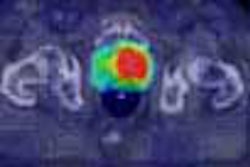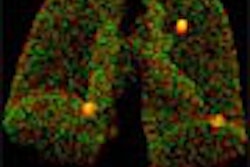Chest films taken to confirm the proper positioning of central venous catheters represent a significant part of the workload for radiology departments at many U.S. hospitals. So is it possible that all these x-rays could be replaced by simpler electrocardiograms?
A recent opinion piece in Chest, the journal of the American College of Chest Physicians, argues that ECGs would be faster, easier, and more appropriate than radiographs in most cases. But the author is also quick to acknowledge the unlikelihood of a sea change in this area of American medical practice.
"We tend to be extremely conservative here," said Dr. John E. Madias, a professor of cardiology at Elmhurst Hospital Center in Elmhurst, NY, in an interview with AuntMinnie.com. "To have something like this really prevail here (in the U.S.) may take centuries."
Intracardiac (IC) ECG monitoring of central venous catheter placement has been used by European anesthesiologists and nephrologists in thousands of cases, Madias noted. Earlier authors have described the use of IC ECGs for positioning of ventriculoatrial shunts and other purposes.
In his Chest article, Madias described the use of IC ECGs specifically for the placement of Shiley central venous catheters (SCVCs) for hemodialysis of critical care patients. The technique involves using the saline-filled catheter itself as an ECG electrode, enabling confirmation of the catheter’s position during and after insertion.
The method described by Madias involves plugging the hub of the catheter with a rubber-headed plastic adapter and using a syringe to infuse saline through the rubber into the catheter. The needle of the syringe is then connected to the V1 cable of the ECG machine by an alligator clamp.
"When the tip of the SCVC is in the SVC (superior vena cava) or is at its junction with the RA (right atrium), the recorded P wave reveals an entirely negative complex, which becomes larger as the catheter is inserted deeper into the SVC," Madias wrote. "When the totally negative P wave is replaced by a positive/negative deflection, the tip has reached the high atrium/mid-atrium, and a totally positive P wave suggests that the tip is at the low atrium and is about to cross the tricuspid valve" (Chest, December 2003, Vol. 124:6, pp. 2363-2367).
"As the SCVC tip approaches the low RA, the amplitude of the corresponding QRS complex increases," Madias wrote. "An IC ECG during the insertion of a SCVC should be recorded via the distal (tip) lumen, which also provides a larger P wave than the one obtained from the proximal lumen, the opening of which is situated 3.5 cm from the tip."
The "operator," Madias concluded, should document proper placement with an IC ECG recording obtained from the distal lumen after the catheter has been securely anchored.
But this designation begs the question of who is actually going to do the ECG monitoring he describes.
When consulting on a case, Madias said he will do the ECG monitoring himself. But routinely bringing a cardiologist in for catheter placements may be a non-starter at many institutions.
Confirming the proper placement of SCVCs by some method is vitally important, since potential complications include arrhythmias, pneumothorax, hematomas, central vessel or chamber perforation, hemothorax, hemopericardium, and cardiac tamponade.
"Even when the SCVC finds its way into the central circulation, concern remains about whether the catheter tip has extended deeply into the RA or even into the right ventricle, thus setting the stage for possible supraventricular or ventricular arrhythmias," Madias wrote.
ECGs may not be a feasible alternative when patients have a preexisting arrhythmia. Madias added that chest radiographs would still be needed if patients developed symptoms during a procedure, when the procedure was laborious or took many punctures, or if the IC ECGs were of questionable quality.
But using ECG confirmation rather than waiting for chest x-rays to be processed could eliminate a delay in dealing with such complications, and would also enable the immediate hemodialysis of the patients who need it, Madias noted. But it would involve a major shift in standard practice.
"Asking for a ‘chest film’ is an ingrained, ‘reflex-like’ action taken by almost all physicians in critical care areas," wrote Madias. Ironically, the anteroposterior radiographs that result from those orders give doctors a false sense of security, he added.
"For the purpose of being sure of the position of the tip and the course of an inserted central venous catheter (CVC), a complementary lateral chest radiograph is needed, but it is rarely obtained in critical care units," Madias said.
By Tracie L. ThompsonAuntMinnie.com staff writer
March 5, 2004
Related Reading
Routine chest x-rays don’t enhance thoracotomy catheter assessment, March 24, 2003
Tips and techniques for decubitus and oblique chest x-rays, December 21, 2001
Mastering AP and lateral positioning for chest x-ray, November 20, 2001
Good positioning is key to PA chest x-ray exams, October 19, 2001
Copyright © 2004 AuntMinnie.com



















